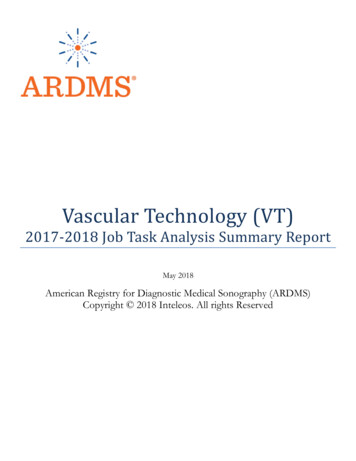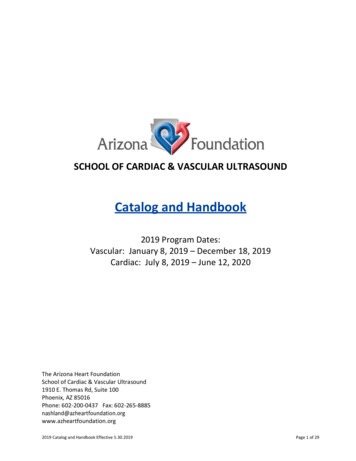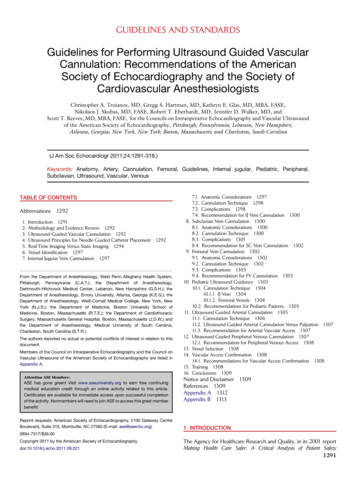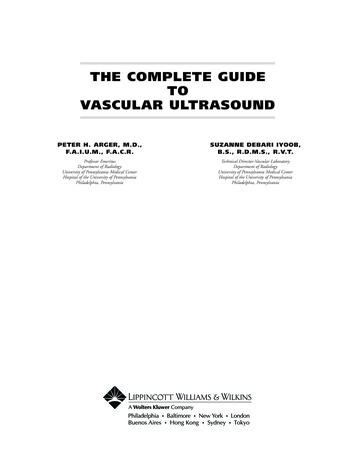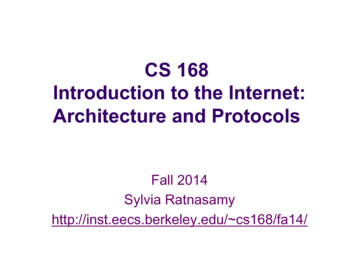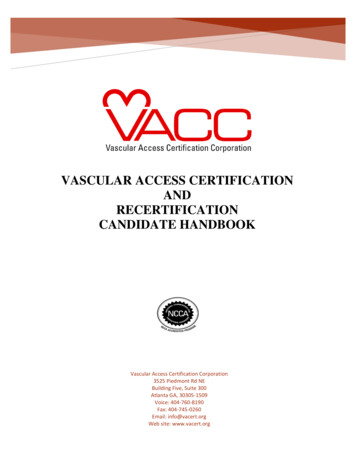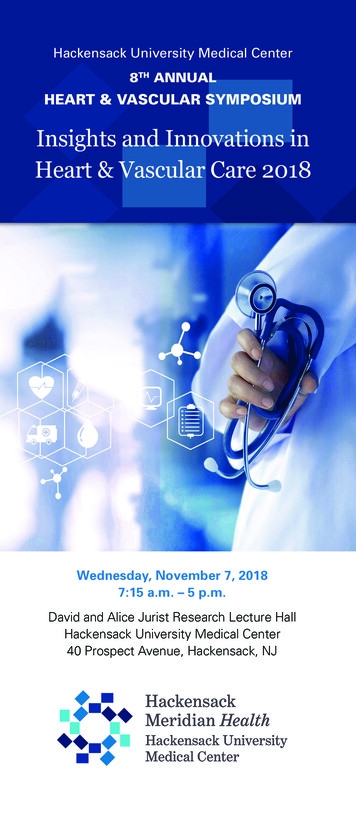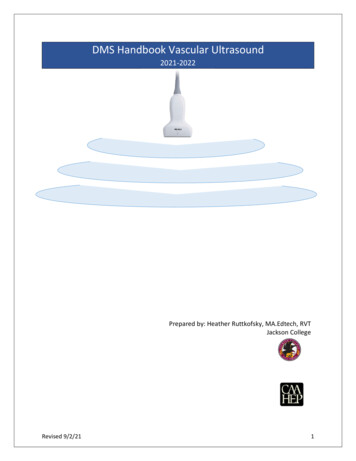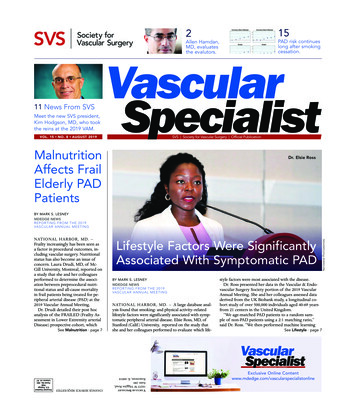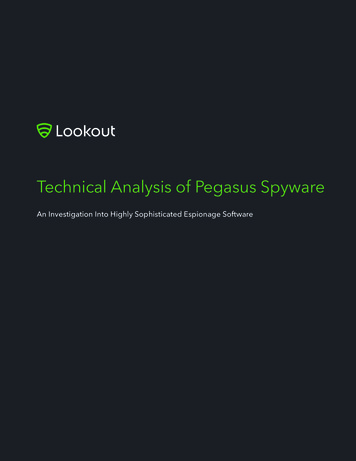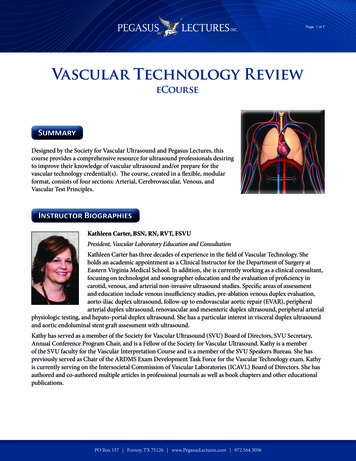
Transcription
Page 1 of 7Vascular Technology RevieweCourseSummaryDesigned by the Society for Vascular Ultrasound and Pegasus Lectures, thiscourse provides a comprehensive resource for ultrasound professionals desiringto improve their knowledge of vascular ultrasound and/or prepare for thevascular technology credential(s). The course, created in a flexible, modularformat, consists of four sections: Arterial, Cerebrovascular, Venous, andVascular Test Principles.Instructor BiographiesKathleen Carter, BSN, RN, RVT, FSVUPresident, Vascular Laboratory Education and ConsultationKathleen Carter has three decades of experience in the field of Vascular Technology. Sheholds an academic appointment as a Clinical Instructor for the Department of Surgery atEastern Virginia Medical School. In addition, she is currently working as a clinical consultant,focusing on technologist and sonographer education and the evaluation of proficiency incarotid, venous, and arterial non-invasive ultrasound studies. Specific areas of assessmentand education include venous insufficiency studies, pre-ablation venous duplex evaluation,aorto-iliac duplex ultrasound, follow-up to endovascular aortic repair (EVAR), peripheralarterial duplex ultrasound, renovascular and mesenteric duplex ultrasound, peripheral arterialphysiologic testing, and hepato-portal duplex ultrasound. She has a particular interest in visceral duplex ultrasoundand aortic endoluminal stent graft assessment with ultrasound.Kathy has served as a member of the Society for Vascular Ultrasound (SVU) Board of Directors, SVU Secretary,Annual Conference Program Chair, and is a Fellow of the Society for Vascular Ultrasound. Kathy is a memberof the SVU faculty for the Vascular Interpretation Course and is a member of the SVU Speakers Bureau. She haspreviously served as Chair of the ARDMS Exam Development Task Force for the Vascular Technology exam. Kathyis currently serving on the Intersocietal Commission of Vascular Laboratories (ICAVL) Board of Directors. She hasauthored and co-authored multiple articles in professional journals as well as book chapters and other educationalpublications.PO Box 157 Forney, TX 75126 www.PegasusLectures.com 972.564.3056
Page 2 of 7Frank Miele, MSEEPresident, Pegasus Lectures, Inc., Dallas, TexasFrank graduated cum laude from Dartmouth College with a triple major in physics,mathematics, and engineering. While at Dartmouth, he was a Proctor Scholar and receivedcitations for academic excellence in comparative literature, atomic physics and quantummechanics, and real analysis. After co-teaching a course in digital electronics at Dartmouth,Frank was a research and design engineer and project leader, designing ultrasound equipmentand electronics for more than ten years at Hewlett Packard Company. Frank was the vicepresident of R&D and chief scientist for a non-invasive hemodynamic measurement medicaldevice company in California. As a designer of ultrasound, he has lectured across the countryto sonographers, physicians, engineers and students on myriad topics. Frank also served as the chief scientist andVice President of Research and Development for a small medical company designing non-invasive hemodynamicbased measurements.Frank has authored multiple books including Ultrasound & Physics Instrumentation and Essentials of UltrasoundPhysics, the Board Review Book. Additionally, Frank has produced multiple educational videos, created ExamSimulation programs, as well as created the patented analysis algorithm method and apparatus for evaluatingeducational performance. He is a co-editor and author for the ASCeXAM Simulation DVD and the RPVI ExamSimulation CD. Frank has served on the faculty for the Society of Vascular Ultrasound and Society of VascularSurgery and is credited with several ultrasound and medical device patents, trade secrets, and publications. Frank isalso currently on the Board of Advisors for Imaging the World (ITW), a non-profit organization bringing medicalimaging capabilities to underserved countries as recognized by the World Health Organization.Rita Shugart, RN, RVT, FSVUPresident, Shugart ConsultingRita Shugart is nationally recognized as a leader in the field of vascular technology. Prior toforming Shugart Consulting in February 2008, Rita managed a large, office-based vascular laband was a practice manager for a cardiac, thoracic and vascular surgery practice for morethan 40 years.Rita has participated in numerous professional activities since the 1970’s. She is a FoundingMember and Past President of the North Carolina Vascular Technologists. Rita has served onthe Board of Directors of the Society for Vascular Ultrasound (SVU) several times since the1980’s, completing terms as Secretary, Vice President, and President. She authored SVU’s Code of Ethics, was electedto its first class of Fellows in 1997, and has been the recipient of its highest service and leadership awards. In 2001Rita found and became the first President of the North Carolina Vascular Nurses Association.Rita has been a member of the Board of Directors of the Intersocietal Commission of Vascular Laboratories (ICAVL)since 1995, and in 2005 she was honored to be elected its first non-physician President. Since 2007, she has been amember of the Board of Directors of the Intersocietal Accreditation Commission (IAC), the parent organization ofICAVL, ICAEL, ICANL, ICAMRL, and ICACTL. She is currently Chairman of the IAC.Rita is a frequent speaker at local, regional, and national conferences, specializing in the topics of lab management,Medicare compliance, current issues, coding and billing, and accreditation. In addition to serving on the AdvisoryCouncil for the local community college’s ultrasound program, Rita is also a member of several committees, andadvisory councils dedicated to promoting the adoption of measures, regulations, legislation, and policy initiativesthat enhance quality in diagnostic testing.PO Box 157 Forney, TX 75126 www.PegasusLectures.com 972.564.3056
Page 3 of 7Steven R. Talbot, RVT, FSVUTechnical Director Vascular Lab University of Utah Medical CenterResearch Associate Division of Vascular SurgerySteven R. Talbot is a Registered Vascular Technologist with over 35 years of experience in thefield. He is currently the Technical Director of the Vascular Lab and also a Research Associatein the Division of Vascular Surgery at the University of Utah Medical Center in Salt Lake City,Utah.Steve was awarded the prestigious Pioneer Award by the Society for Vascular Technology forbeing the first to identify the role of ultrasound in the diagnosis of venous disease. He hasspent much of his professional career writing and lecturing on the subject. Steve is also currently serving as theEditor of the Journal for Vascular Ultrasound.ECourse Features Flexible ViewingDual Video StreamingInteractive QuestionsViewable Playlist Modular DeliverySynchronized ScanningCustomized ReviewIntegrated Note-Taking Printable PowerPoint15 SVU CME credits Prepare with Pegasus and PASS!Guaranteed.PO Box 157 Forney, TX 75126 www.PegasusLectures.com 972.564.3056
Page 4 of 7Arterial ReviewVTArt1: Anatomy and History37 minutesIn this module, Kathy Carter BSN, RN, RVT, FSVU discusses upper and lower arterial anatomy, risk factors,mechanisms and stages of disease, non-atherosclerotic disease, history taking, and physical examination.VTArt2: Physiologic Testing1 hour 4 minutesIn this Physiologic Testing module, Kathy Carter BSN, RN, RVT, FSVU discusses normal and abnormal lowerextremity hemodynamics, pleythysmography (PVR, PCR, VPR, PPG), segmental pressures, Doppler velocitywaveforms, and exercise testing, pulsatility indices, acceleration rise time with interactive cases.VTArt3A: Duplex and Graft Imaging1 hour 12 minutesIn the fourth of the seven Peripheral Arterial modules topics covered include the technique and technicalconsiderations of B-mode, Doppler and Color Doppler in arterial duplex scanning, pre-intervention duplex,rationale for surveillance, post endovascular assessment, location and types of bypass grafts, scan protocols anddiagnostic criteria. The module concludes with multiple case presentations.VTArt3B: Aortoiliac and Endografts40 minutesThe module begins with a discussion of trauma duplex, pseudoaneurysms and technique for DDTI followed byAAA, the protocol and scan technique of aortoiliac duplex scan, aortic endografts, types of endoleaks and the useof other imaging modalities in the evaluation of aortoiliac disease.VTArt4A: Renovascular46 minutesTopics covered in this module include visceral anatomy, hemodynamics of renal artery disease, technique andtechnical considerations of renal artery duplex Ultrasonography, renovascular resistance, assessment of renalstents, diagnostic criteria and incidental findings in renal duplex imaging.VTArt4B: Mesenteric21 minutesIn the sixth of a seven module Peripheral Arterial Review eCourse, Kathy Carter BSN, RN, RVT, FSVU discussesmesenteric anatomy and mesenteric vascular disease, including acute mesenteric disease, ischemic colon disease,celiac axis syndrome and mesenteric venous occlusion.PO Box 157 Forney, TX 75126 www.PegasusLectures.com 972.564.3056
Page 5 of 7VTArt4C: Hepatoportal16 minutesThis module begins with a discussion of the anatomy and pathophysiology of the liver followed by normalvasculature and hemodynamics. The nest section covers abnormal hemodynamics which includes portalhypertension, abnormal portal vein flow and collateral pathways, portal vein thrombosis, hepatic vein thrombosisand Budd-Chiari Syndrome.Cerebrovascular ReviewVTCerebro1: Cerebrovascular Review Part 11 hourRita Shugart RN, RVT, FSVU presents Module 1 of the Cerebrovascular Review beginning with extracranialand intracranial anatomy with anatomical variants followed by a discussion of the primary mechanisms ofcerebrovascular disease. Patient history, clinical symptomatology and physical assessment are reviewed. Thismodule concludes with a segment covering extracranial vessel identification, flow patterns and plaque morphologyin carotid duplex scanning.VTCerebro2: Cerebrovascular Review Part 21 hr 56 minutesIn Module 2 of the Cerebrovascular Review, Rita Shugart, RN, RVT, FSVU coverscarotid duplex protocols and practical scanning tips. A review of carotid interpretationincludes current diagnostic criteria, correlation criteria and techniques to identifyconditions causing over and underestimation of carotid velocities. Rita also addressmiscellaneous pathology which may be encountered during a carotid duplex examincluding subclavian steal, carotid dissection, carotid body tumor, fibromusculardysplasia and neointimal hyperplasia. A segment on Transcranial Doppler and Imagingidentifies intracranial anatomy, insonation windows, vessel depth, velocities, anddirection of flow. This module concludes with a review of various correlation methods.Venous ReviewVTVen1: Venous Insufficiency27 minutes“What Goes Up, Shouldn’t Come Down” is the alternate title for this lecture on Venous Insufficiency. In thismodule, Steve Talbot, RVT, FSVU discusses the pathophysiology of venous reflux, the best methods to detectreflux and current diagnostic criteria. Escape points, the pre-terminal and terminal valves and major branches ofthe great saphenous vein are covered. This module concludes with a review of perforator incompetence and venoushypertension.PO Box 157 Forney, TX 75126 www.PegasusLectures.com 972.564.3056
Page 6 of 7VTVen2: Venous Thrombi Part 11 hr 15 minutesThis lecture is the first of a two part series on deep vein thrombosis. Uniquely presented by Steven R. Talbot, RVT,FSVU, the first vascular technologist to discover the technique and application of venous imaging, this lecturebegins with a review of the pathophysiology and mechanisms of venous disease. By understanding the factorscontributing to the formation of venous thrombosis and embolus, characterization of acute and chronic thrombusbecomes much easier. A review of venous anatomy includes microscopic anatomy and upper and lower venousvessels, and veins of the thorax, abdomen and pelvis. Venous protocols, vein mapping technique and diagnosticcriteria is discussed.VTVen3: Venous Thrombi Part 257 minutesThis lecture is the second of a two part series on deep vein thrombosis. Beginning with a review of patienthistory and venous disease presentation, Steve Talbot RVT, FSVU presents venous imaging diagnostic criteria fordetection of DVT and venous reflux, including tips on the information a vascular sonographer should present tothe interpreting physician. Treatment methods discussed include medical therapy and surgical intervention. Asection on venous physiology and physiologic testing concludes this module.Vascular Test PrinciplesVTHemo: Hemodynamics2 hours 16 minutesThe laws that govern fluid dynamics generally seem outside the intuitive grasp of many people. In this modulewe begin with a simple analogy which puts the complex content of his often scary topic in terms of a story towhich everyone can relate. From this analogy, not only are general fluid dynamic principles appreciated, butalso the foundation of the fluid dynamic equations is derived. Further use of analogies and thought experimentswill then allow us to derive all of the equations needed, including the resistance equation, the simplified law ofhemodynamics, the continuity equation, Poiseuille’s Law, and the Bernoulli equation. Once the equations arederived, we develop a conceptual appreciation of the equations through direct application in various clinicalsituations. Finally, we will learn how to relate the Doppler spectral characteristics with the hemodynamic conceptsjust learned.VTStat: Statistics31 minutesIn this module, Frank Miele explains the statistical parameters used to compare various aspects of a clinical testthat laboratories want to validate against a gold standard test. In addition to being an essential component of anyquality assurance program, this statistical information will also prove very useful for labs undergoing laboratoryaccreditation.PO Box 157 Forney, TX 75126 www.PegasusLectures.com 972.564.3056
Page 7 of 7VTTest: Test-Taking Strategies1 hourThe ability to perform well on a multiple choice test is a skill that requires both forethought and practice. In thismodule, some very unique techniques are taught which will significantly change your test taking approach, as wellas improve your test taking abilities. Within this module we will discuss concepts which include how best to read atest question, how to approach answering a test question, types of questions, distracter types, dealing withquestions of inversion, logic and reasoning skills, and intelligent use of scrap paper. Additionally, specific testquestions are given which allow for direct application of these concepts.Complete Vascular Technology eCourse (15 modules):Core Concepts: 15.00 hrsFocus Sessions 11.25 hrs (optional)For more information:Carol Gannon RN, RVT, RDCS, FSVUcgannon@pegasuslectures.com972-564-3056PO Box 157 Forney, TX 75126 www.PegasusLectures.com 972.564.3056
Vascular Technology Review eCourse çÃà Ùù Designed by the Society for Vascular Ultrasound and Pegasus Lectures, this course provides a comprehensive resource for ultrasound professionals desiring to improve their knowledge of vascular ultrasound and/or prepare for the vascular techno
